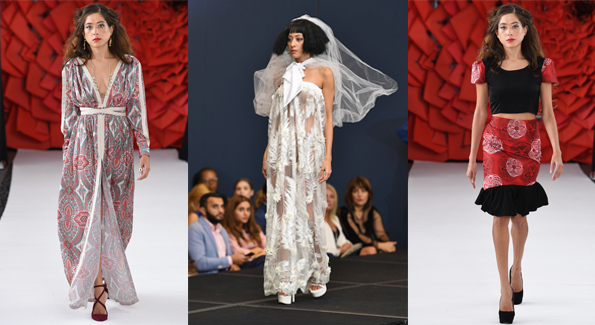The neurology resident moonlights as a fashion model.
By Hanna Nakano

Dr. Farah Fourcand walking the runway at DC Fashion Week (Photos Courtesy of DC Fashion Week)
Eighty hours a week, Farah Fourcand goes by Dr. Fourcand. She’s a neurology resident, whose heels click down the halls of Georgetown University Hospital. But sometimes – when the stars align, and her days off match up with the largest modeling and fashion events in the world – Dr. Fourcand trades in her stethoscope and white coat for a couture walk on the runway.
Farah is inarguably stunning. Her high, angular cheekbones, large, bright eyes and graceful demeanor are undoubtedly reasons her parents encouraged her to pursue a career in modeling. But what Farah has in beauty, she more than doubles in intelligence – and she’s not one to let a drop of anything go to waste.
“It’s something that my family and friends always kind of suggested I do growing up, but I decided to focus on other things,” Farah tells Washington Life. “So I went to college, went to medical school, started residency – and it wasn’t until a year ago that I thought: I’m going to get into this.”
On a whim, she entered the Miss DC pageant last year, and while she didn’t win the crown, she did walk away with an agent. The president of Avant Protégé Talent Management & Agency approached her backstage and asked her to walk in an event the next week. Farah couldn’t; she had to be at the hospital.
Then the agent told her about shows and events at New York Fashion Week.
Farah checked her calendar.
“I said, ‘Yes, I’m going to do that!’” Farah said. “And it worked out with my schedule, but if it didn’t I wouldn’t have been able to, because medicine, my responsibilities, always come first.”
Her job, her responsibility, is more than a means to a paycheck. For Farah, medicine is a calling. One she’s felt since she was 10-years-old.
Like many who enter the medical field, life experience guided her path. Growing up, Farah saw family members succumb to neurological and mental illness. Working with the same type of disorders she experienced at home gives her a unique sense of empathy. Every patient is personal.
“Even though some times were very difficult and I had to grow up very quickly, it by no means held me back. It by no means gave me a sense of learned helplessness,” she said. “It motivated me. I think that is the driving force behind me becoming a doctor.”
Farah earned her undergraduate degree from the University of Miami and attended medical school at Florida International University. Now, at Georgetown, she is one of a handful of residents working and researching in partnership with the National Institutes of Health.
She’s the first to admit, the life of a medical resident is more than trying. Eighty-hour workweeks are no joke, top that off with studying for board exams and prepping for presentations in front of attending physicians and it’s easy to see why you may loose track of your doctor friends the first few years of their career.
Farah, though, says she’s found the secret to maintaining a life: keeping up with hobbies outside of the hospital.
“I think it’s extremely important, especially in the medical profession. It centers you; it prevents you from getting cynical. I feel like when you make time to do things for you, no matter what that is, you come to work refreshed, patient, ready to take everything in,” Farah said. “When I’m not working, I’m not drained – I worked hard, but I liked my day. I’m passionate about it, so I still have some zest in me, which is why I’m able to do other things.
It doesn’t hurt that she only needs a few hours of sleep a night, either.
When she walked into the dressing area at New York Fashion Week, she was introduced as “The Doctor”. Funny, Farah said, but also a pointed message to the 17 and 18-year-old girls who hope to make this type of modeling their career: You can do anything you set your mind to – and then some.
“Modeling can be a career, but I feel like the main reason I want to do this now is that it irks me that a lot of role models now days are overwhelmingly underwhelming. They don’t instill much drive or work ethic or principals – or the idea that you appreciate things so much more when you work for them,” she said. “Even though me doing this is a drop of water in the ocean of possibilities, it’s still something to show that you can do it.”
Farah walked for Francoise Desmangles and Silka by Silk Mitrasari at New York Fashion Week. Fourteen days later, she walked for Corjor International, Ellen London and Transparente Designs at D.C. Fashion Week. She plans to walk the runway at Dubai Fashion Week in April.
